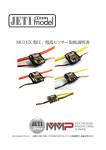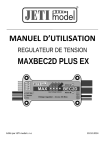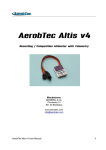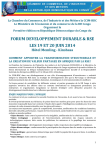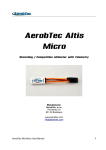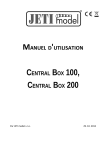Download MVario2 EX: Manual
Transcript
MVario2 ® MVario2 System that measures atmospheric pressure EN User Manual EN MVario2 EN English 1. Description and function ................................................................ 03 1.1 The main function ......................................................................... 03 1.2 Technical data ................................................................................ 04 2. Placement and connection .............................................................. 05 2.1 Placement of MVario2 sensor ................................................... 05 2.2 Connecting the MVario2 sensor ............................................... 05 2.2.1 Connection with the JETIBOX terminal only ............... 05 2.2.2 Connection with a receiver and Duplex transmitter module (non US) ............................................................... 06 2.2.3 Connection via Expander ................................................ 06 3. Setup .................................................................................................... 07 3.1 Setup via JETIBOX ....................................................................... 07 3.1.1 Menu Sensor MVario2 in the environment JETIBOX .. 07 3.2 Setup via DC/DS line transmitters ............................................. 15 3.2.1 Main setup of the MVario2 sensor in the DS/DS transmitters ....................................................................... 15 4. Possible connection ......................................................................... 22 4.0.1 Connection to the JETIBOX ............................................. 22 4.0.2 To the receiver input "Ext." ................................................ 23 4.0.3 Connection via Expander EX .......................................... 24 1 MVario2 EN 4.0.4 Connection to the receiver input (Ext.) with the option to connect more sensors .................................................. 25 4.0.5 Connection directly to the receiver input (Ext.) with the F5J Limiter or ALES Limiter function activated ........... 25 4.0.6 Connection to the receiver input (Ext.) with a possibility of logical levels detection and transmission of these values via telemetry .......................................................... 27 5. Warranty, service and the technical support ............................ 28 2 EN MVario2 MVario2 system that measures atmospheric pressure 1 Description and function English ver. 1.00 MVario2 is a system that measures atmospheric pressure and using the obtained data it calculates the altitude above sea level, airspeed, and the rate of climb as well as the rate of descent. Changes in climb and descent rates are signaled as well. The sensor also alerts you if any alarm setting is exceeded. The sensor data can also be transmitted via the Duplex system to the user. The Duplex system takes advantage of the 2.4GHz band for communication. This system not only transmits control data to the model but also sends data from the model back to the transmitter. The telemetry data collected during operation is shown as actual, measured values in real time on either LCD screen of a connected JETIBOX or on the DC/DS JETI model transmitters. 1.1 The main function ● Measurement of altitude, pressure, and temperature. ● Very accurate and fast indication of climb and descent. ● Possible sound alarm signaling using a JETI Tx module (EU only) or JETIBOX profi. ● Possibility to be used as an Expander and to connect other sensors. ● Adjustable compensation of energy (TEK) via MSPEED EX sensor. ● Possibility to be used as an altitude switch in FAI F5J or ALES competition categories. ● The device is compatible with EX Bus protocol, i.e. it is possible to be configured comfortably via a special menu in DC/DS JETI model transmitters. ● Firmware updates. 3 EN MVario2 1.2 Technical data Technical data Dimensions Weight with the cables Measuring accuracy of absolute/relative altitude Resolution of measured height Typical noise ratio in height changes measurement Measurement range Operating temperature Supply voltage Current consumption MVARIO2 35x16x7mm 5g ±9m/±3m 0.1m ±0.05m/s 450÷1100hPa -10÷85°C 3.5 ÷ 8.4V 15mA The sensor enables an acoustic signal for the climb rate/descent rate or for exceeding of a preadjusted limit value. The acoustic signal consists of 4 different kinds (steps) for climbing and the same amount of steps for descending. The step width can be adjusted by the user. The climb signal consists of short interrupted tones, the descent signal consists of long permanent tones. 4 MVario2 EN 2 Placement and connection 2.1 Placement of MVario2 sensor MVario2 is a very sensitive pressure sensor. Any change in pressure causes a change in the indicated altitude, climb rate, etc. The sensor should be mounted in the model in such a way that the sensor is not affected by air pressure flowing inside the model, but only by static atmospheric pressure. In other words, place the sensor in a model where it is only influenced by the static atmospheric pressure. For the most accurate altitude measurement, do not place the sensor near any components that generate heat during flight (e. g. near engines, motors or ESCs). 2.2 Connecting the MVario2 sensor MVario2 has an output marked Ext. and two programmable ports that are labeled as Ext1/ESC In and Ext2/ESC Out. Using the Ext. port of the sensor the data is transmitted to the receiver or to the connected JETIBOX, and it serves as a current supply as well. Possible functions of the programmable pins Ext1/ESC In Disabled Expander ESC/Servo input Logical input No. 1 Ext2/ESC Out Disabled Expander ESC/Servo output Logical input No. 2 2.2.1 Connection with the JETIBOX terminal only The three-wire cable with JR plug (black connector) can be plugged in directly into the JETIBOX (socket with the label Impulse, + - ). For current supply use the second input of the JETIBOX with the (+ - ) label, please apply a voltage of 3.5-8.4V. When taking advantage of this type of connection you must be aware that no wireless data transfer exists and the measured data is 5 MVario2 EN directly shown on the LCD screen of the JETIBOX. This connection type allows no alert signal generation and no acoustic signals of the vario, because the buzzer is a component of the transmitter module (non US) which is not connected in this case. Any alert signals are only shown on the JETIBOX LCD screen. 2.2.2 Connection with a receiver and Duplex transmitter module (non US) Connect the three-wire cable of the MVario2 sensor with JR plug (black connector) to the back side of the Duplex receiver (to the socket marked Ext.). Set the sensor input that is marked as Ext1/ESC In via the JETIBOX to the function of input servo pulses. Connect the input labeled Ext1/ESC In using an additional cable with a JR connector to a free receiver channel. This channel will then, together with the Tx module, function as the control of acoustic signaling for the climb and descent. E.g. the acoustic signaling will be disabled by the switch in one position and by putting the switch in the other position the MVario2 starts indicating the climb/descent ratio. The MVario2 module gets its current supply through the receiver. In order to adjust parameters of the MVario2, connect the JETIBOX to the transmitter module and switch on the receiver and the transmitter. 2.2.3 Connection via Expander Connect the three-wire cable of the MVario2 sensor with JR plug (black connector) to one of the EXPANDER inputs. Provide the MVario2 input labeled Ext1/ESC In with the JR connector, configure it as a servo pulses input, and connect it to a free receiver channel. The expander enables connection of several telemetry sensors to one receiver. In such a case the MVario2 sensor gets its current supply through the Expander and the Expander through the receiver. 6 MVario2 EN 3 Setup 3.1 Setup via JETIBOX The parameters are set and the data is read out via JETIBOX. After connecting to the MVario2 sensor, the welcome screen appears that shows the sensor identification and relative altitude in the first line. The second line contains the indicator and the value of vario (climb/descent rate in meters per second). The vario indicator consists of eight positions. The speed of climb and descent is indicated by the number of filled positions. The „>“ is one step of the climb. The „<“ symbol in one step of the descent. If the D button is pressed, you get to the MVario2 main menu. 3.1.1 Menu Sensor MVario2 in the environment JETIBOX 1. MENU SENSOR: ACTUAL VALUES - by pressing the D button (arrow down) select depicting of actual measured values Rel/Abs Altitude – relative and absolute altitude. After switching on, the device creates a reference (zero) level of the relative altitude based on the absolute altitude. Relative altitude indicates the difference between the actual absolute altitude and the zero reference level. Vario, alternatively Vario/Compensat. – depicts actual speed of the climb/descent in meters per second. Alternatively, in addition to the actual climb / descent rate, the value obtained using the MSPEED EX sensor after the compensation of total energy is depicted. Abs. pressure – depicts actual atmospheric pressure in hPa (hectopascal). Temperature – shows actual temperature of the sensor. ESC In/Out – shows the value of the receiver channel that is connected to the appropriate Ext1/ESC In, respectively Ext2/ESC Out connector (in milliseconds). To display the correct values the 7 MVario2 EN appropriate input and output needs to be configured in the settings of the sensor. 2. MENU SENSOR: MIN/MAX – by pressing the D button (arrow down) select depicting of extremes records that occurred during the measurements Vario MIN/MAX – indicates the minimum descent rate and the maximum climb rate. Altitude MAX – shows the maximum reached relative altitude. Temp MIN/MAX – shows the minimum and maximum temperature of the sensor. FAI Altitude – in FAI F5J mode the „Start height“ of the flight is depicted, which corresponds with the valid FAI F5J rules. Speed MAX – maximum speed measured using a connected MSPEED EX sensor. Reset MIN/MAX – manual reset of the maximums and minimums, followed by reinitialization of the altimeter. Pushing R and L arrows (right and left) together deletes the extremes of all measured parameters. 3. MENU SENSOR: SETTING – by pressing the D button (arrow down) you get to the basic setting of the MVario2 sensor. Device mode – enables fast setting of the basic function of the sensor. See the available options below: ● Vario – standard universal mode for most applications. In this mode it is possible to arbitrarily set the Ext1/ESC In and Ext2/ESC Out ports, it also enables the use of an MSPEED EX sensor to compensate the total energy. ● F5J Limiter – special mode for training flights of FAI F5J category. In this mode the Ext1/ESC In port serves as the throttle channel input, conversely the Ext2/ESC Out port is used as the output to connect an electronic speed controller. 8 MVario2 EN Note: For competition flights in FAI F5J category there exists a separate firmware that is freely available to be downloaded on „www.jetimodel.com” and is always marked with its version MVARIO2 V. FX.XX. This firmware has been made as simple as possible, the telemetry functions are blocked and is possible to be used only as an altitude limiter. ● ALES Limiter – special mode for ALES type categories (Altitude Limited Electric Soaring). In these categories the motor is automatically switched off after exceeding the set altitude or after elapsing specified motor time (which ever event occurs first). The Ext1/ESC In port serves as throttle channel output from the receiver, conversely the Ext2/ESC Out port is used to connect the electronic speed controller. Ext1 Mode, respectively Ext2 Mode – if the device is in the Vario mode, the Ext1/ESC In port, resp. Ext2/ESC out port can be configured to several functional alternatives: ● Off (by default) – the port has no function. ● Expander – it is possible to connect any sensor to the port (sensors using JETIBOX, Duplex EX and EX Bus protocols are supported). Detection of the MSPEED EX sensor presence is done automatically. ● ESC/ServoIn – the port is configured as the servo impulses input from any receiver channel. Based on the value of the appropriate channel deflection it is possible to enable or disable generating the acoustic signals for climb/descent rate. These are further indicated by the transmitter module or by connected JETIBOX profi. This operation is valid for Ext1/ESC In port only. ● ESC/ServoOut – the port is configured as the servo impulses output. In the Vario mode there is the same deflection on the output as on the input of Ext1/ESC In, in other modes (F5J Limiter and ALES Limiter) this port serves as throttle channel control and 9 EN MVario2 is set automatically. This option is valid for Ext2/ESC Out port only. ● Log. input – the port will be switched to the digital input mode. Detected value (log. 1 or log. 0) is then available through EX telemetry and e.g. in the DC/DS transmitters it is possible to assign any action on the basis of the sensor logical input. Voltage threshold levels table Log. 0 Log. 1 Voltage range 0 – 1V 1.9 – 3.3V Cut-off Altit. – in the ALES mode this parameter sets the altitude where the motor is switched off (50 – 500m, default value 200m). Cut-off Time – in the ALES mode this parameter sets the maximum possible time of the motor operation. After this period elapses, the motor is automatically switched off (1 – 120s, default value 30s). Motor off – In the ALES and F5J modes it indicates the value of the throttle channel, which is understood as the switched-off motor. Exceeding this deflection (by default 1.1ms) starts countdown time for running motor. Vario sensitiv. - influences the filtering of input data from the pressure sensor. The higher the sensitivity is, the faster the responses to the altitude changes are. Nevertheless it is possible that at the same time the level of indicated noise gets increased. Medium sensitivity is set by default. MSPEED Compensat – determines the level of total energy compensation (TEK) by means of an MSPEED EX sensor. By default, the compensation is disabled. The value is available as a specific EX parameter. For proper function of the compensation it is necessary to switch the Ext1 or Ext2 port to the Expander mode and connect the MSPEED EX sensor to this port. The sensor is detected automatically. For initial setup we recommend the value of 50% and subsequent additional experimentation depending on the flight tests conducted. 10 MVario2 EN Proper setup of the total energy compensation is used to suppress the effects of control changes on the sound alarms. E.g. after pulling the elevator, climbing is not signaled although the altitude of the model increases. On the contrary, descending will still be indicated as when pulling the elevator the speed decreases. This brings the model to aerodynamically less favorable conditions. Round altitude – permits or denies rounding the altitude values sent via EX telemetry and is possible to be displayed on the transmitter or the JETIBOX profi. Relative and absolute altitude round to full meters, so if the voice output is activated, the transmitter announces the actual altitude without the decimal part. Sealevel Press – to calculate the absolute altitude the atmospheric pressure at the sea level is taken as a reference. To get the most accurate calculation of the altitude, set the current pressure in the area adjusted to the sea level. This parameter is not available in F5J and ALES modes. 4. MENU SENSOR: ALARMS/VARIO - by pushing the button D (downward arrow) you will get to the setup of particular alerts and to the sound indication of the MVario2 sensor. If an adjusted parameter is exceeded, the LCD screen of the JETIBOX then shows alternately the original data and the matching alert in the second line of the main screen and the buzzer of the transmitter module emits the alert signal. The first tone is the revelation tone and the second tone beeps out the Morse code of the character representing the corresponding alert. If the alert is in position OFF, the given alert is switched off. Beep/Alrm Enable – Using this parameter it is possible to disable all the acoustic signaling of the sensor. In case you use JETI Duplex transmitter module or JETIBOX profi, enable the sound signalization (Beep/Alrm Enable = Yes). Conversely if you use the DC/DS transmitters, we recommend keeping the sound 11 MVario2 EN signaling disabled, as all the other settings (alarms, vario signaling) are carried out in the transmitter directly via EX parameters. Climb Sens., descent – setting the sensitivity of the sensor, which defines the value of the indicator step in the initial screen and of the sound signaling step. The sensitivity is set separately for climb and descent. (E.g. to setup the sensitivity on 1m: If the vario indicator is fully filled in the main screen, the level of climb/descent is 4m/s and the sound signalization step is ±1m/s) Beep Period – setting the time between the groups of tones in vario sound signaling. The number of tones corresponds with the change of climb / descent that appeared during this set period Trigger Level – setting the value of input impulse length. If this level is exceeded, the rate of climb/descent is acoustically signaled. If the MVario2 input is not connected to a receiver channel, the acoustic signaling is enabled permanently. (We recommend connecting the input to the receiver channel that is controlled by a switch on the transmitter or by the channel controlling the throttle.) Vario Beep – adjustment of one of the 4 modes of vario sound signaling. If the „Yes“ option is active, the sound signaling of both climb and descent is enabled. In „On-Descent“ only the sound signaling for the descent is active, and in „On-Climb.“ Only the sound signaling of the climb is active. In the „Off“ mode the sound signaling is disabled. These settings do not apply to the configured alarms, which are permanently enabled. (In case you want to be informed only about exceeding the set alarm, it is necessary to disable the vario signaling. We recommend not to have set alarms and vario signalization enabled at the same time.) Vario High Alarm – adjustment of the signal representing high climb rate. If the value measured by the Vario exceeds the set value, the alert will be activated. Vario Low Alarm – adjustment of the signal representing high 12 MVario2 EN descent rate. If the value measured by the Vario exceeds the set value, the alert will be activated. Beep Vario Alarm – adjustment of one Morse code letter, which represents exceeding the set vario alarm by the sound tone from the Duplex Tu transmitter module. Alti High Alarm - adjustment of the signal representing the relative altitude. If the value of the relative altitude exceeds the set value, the alert will be activated. Beep Alti. Alarm – adjustment of one of the Morse code letters, which represents exceeding the set altitude alarm by the sound from the Duplex Tx transmitter module. 5. MENU SENSOR: EX PARAMETERS MVario2 offers following telemetry values to be displayed in the transmitter or in the JETIBOX profi: 13 MVario2 No. Designation MVAR2 1. Vario 2. Abs. Altit 3. Rel. Altit 4. Air press. 5. Temp. 6. Servo out 7. FAI altit 8. Com. Vario 9. Log Input1 EN Description The name of the sensor Climb/descent indication with a resolution of 0.01m/s. Absolute altitude above the sea level with the resolution of 0.1m. Relative altitude above the reference level with the resolution of 0.1m. Atmospheric pressure in hectopascals. Temperature of the sensor. The value of the output impulse for the servo or speed controller, in milliseconds. In the F5J Limiter mode the ‘Start Height’ of the flight is depicted here. The calculation is carried out according to the procedure described in the valid version of the rules. Climb/descent indication with the use of the speed change compensation. The value of log. 1 or log. 0 detected on the Ext1/ESC In port. 10. Log Input2 The value of log. 1 or log. 0 detected on Ext2/ESC Out port. 11. Status Coded device status. 0 ... Device initialization 1 ... F5J and ALES modes: waiting for the throttle idle position. 2 ... The device is ready 3 ... F5J and ALES modes: the engine is running 4 ... F5J mode: The engine is stopped and there is a countdown of 10 seconds running 5 ... F5J mode: FAI altitude (‘Start Height’) has been measured, ALES mode: the engine is switched off and the cut-off altitude has been measured The parameters can be excluded from the EX telemetry protocol, so if needed, the unnecessary data will not be sent at all. Then, the display on neither the DC/DS transmitters nor the JETIBOX profi will show these parameters. If you disable some parameters, the other enabled data will be sent more frequently (but 100ms is the limit of the repetition period). 6. MENU SENSORU: SERVICE Factory Defaults - by simultaneous pressing of arrows R and L (right and left) the factory settings of the MVario2 are loaded. 14 MVario2 EN 3.2 Setup via DC/DS line transmitters MVario2 sensor can be easily configured via any transmitter of DC/DS line. If you switch the paired receiver to the EX Bus mode and you connect the MVario2 to its Ext. port, the device will be detected automatically and then might be configured in the menu „Model ->Device Explorer”. Note: For proper function the transmitter version at least 2.20 (or newer) and the receiver version 3.14 (or newer) is necessary. Further, make sure that in the Devices folder of your SD card there is a configuration file MVARIO2.bin. 3.2.1 Main setup of the MVario2 sensor in the DS/DS transmitters 1. Device mode – enables fast setup of the basic function of the sensor. These possibilities are available: ● Vario – standard universal mode for most of applications. In this mode it is possible to adjust Ext1/ESC In and Ext2/ESC Out ports arbitrarily. It is also possible to use the total energy compensation using the MSPEED EX sensor. ● F5J Limiter – special mode for training flights in the FAI F5J competition category. In this mode, the Ext1/ESC In port serves as the throttle channel input from the receiver, on the contrary, the Ext2/ESC Out port is used as the output connection for an electronic speed controller. 15 MVario2 EN Note: For competition flights of the FAI F5J category, there exists a separate firmware that is freely available to be downloaded on „www.jetimodel.com” and is always marked with its version MVARIO2 V. FX.XX. This firmware has been made as simple as possible, the telemetry functions are blocked and is possible to be used only as an altitude limiter. ● ALES Limiter – special mode for the ALES type categories (Altitude Limited Electric Soaring). In these categories the motor is automatically switched off after exceeding the set altitude or after the elapsed specified motor time (which ever event occurs first). The Ext1/ESC In port serves as throttle channel output from the receiver, conversely, the Ext2/ESC Out port is used to connect an electronic speed controller. Ext1, resp. Ext2 modes – if the device is in the Vario mode, the Ext1/ESC In, resp. Ext2/ESC out ports can be configured to several functional alternatives: ● Off (by default) – the port has no function. ● Expander – it is possible to connect any sensor to the port (sensors using JETIBOX, Duplex EX and EX Bus protocols are supported). Detection of the MSPEED EX sensor presence is done automatically. ● ESC/ServoIn – the port is configured as the servo impulses input from any receiver channel. Based on the value of the appropriate channel deflection it is possible to enable or disable generating the acoustic signals for climb/descent rate. These are further indicated by the transmitter module or by connected JETIBOX profi. This option is valid for Ext1/ESC In port only. ● ESC/ServoOut – the port is configured as the servo impulses output. In the Vario mode there is the same deflection on the output as on the input of Ext1/ESC In, in other modes (F5J Limiter 16 MVario2 EN and ALES Limiter) this port serves as throttle channel control and is set automatically. This option is valid for Ext2/ESC Out port only. ● Log. input – the port will be switched to the digital input mode. Detected value (log. 1 or log. 0) is then available through EX telemetry and e.g. in the DC/DS transmitters it is possible to assign any action on the basis of the sensor logical input. 2. The limiter setup is displayed in the ALES Limiter and F5J Limiter modes. Cut-off Altitude – in the ALES mode this parameter sets the altitude where the motor is switched off (50 – 500m, default value 200m). Cut-off Time – in the ALES mode this parameter sets the maximum possible time of the motor operation. After this period elapses, the motor is automatically switched off (1 – 120s, default value 30s). Motor off – In the ALES and F5J modes it indicates the value of the throttle channel, which is understood as the switched-off motor. Exceeding this deflection (by default 1.1ms) starts the countdown time for running motor. 3. The vario setup Sea Level Pressure – to calculate the absolute altitude the atmospheric pressure at the sea level is taken as a reference. To get the most accurate calculation of the altitude, set the current pressure in the area adjusted to the sea level. The current altitude will also be displayed. This parameter is not available in F5J and ALES modes. EX Sensitivity – influences the filtering of input data from the pressure sensor. The higher the sensitivity is, the faster the 17 MVario2 EN responses to the altitude changes are. Note: as the sensitivity is increased the potential for unwanted noise is also increased. Medium sensitivity is set by default EX Round Altitude – permits or denies rounding the altitude values sent via EX telemetry and is possible to be displayed on the transmitter or the JETIBOX profi. Relative and absolute altitude round to full meters, so if the voice output is activated, the transmitter announces the actual altitude without the decimal part. Generate JETIBOX Alarms – enables or disables generating the alarms and acoustic indication directly from the sensor. This parameter serves just for the checkup, we recommend to keep the alarms disabled. If you enable the alarms (Generate the JETIBOX alarms = YES), it is necessary to set the relevant values and signal types using the built-in JETIBOX emulator. MSPEED Energy compensation – determines the level of total energy compensation (TEK) by means of MSPEED EX sensor. By default, the compensation is disabled. The value is available as a specific EX parameter. For proper function of the compensation it is necessary to switch the Ext1 or Ext2 port to the Expander mode and connect the MSPEED EX sensor to this port. The sensor is detected automatically. For initial setup we recommend Vario mode ALES Limiter mode 18 MVario2 EN the value of 50% and subsequent additional experimentation depending on the flight tests conducted. Proper setup of the total energy compensation is used to suppress the effects of control changes on the sound alarms. E.g. after pulling the elevator, the resulting climb is not signaled although the altitude of the model increases. On the contrary the descent will still be indicated, as when pulling the elevator the speed decreases. This brings the model to aerodynamically less favorable conditions. 4. Telemetry Here is a quick view of the possible measured values available to the sensor. The Enabled in EX parameter sets that the given variable will be available to the transmitter as EX telemetry. If needed, unwanted parameters can be disabled. Thus it will not be possible to assign them to the telemetry screen of the transmitter and they will not be sent either. The transmitters support a limited number of sensor variables and in this way you get the space for connecting more sensors. 19 MVario2 EN If some parameters are disabled, the remaining ones will be sent more frequently (but 100ms is the limit of the repetition period). 5. Measured minimums and maximums In this menu you can display measured minimum and maximum values. These values can be easily reset using „Clear and reinitialize now“. After confirmation the sensor is reinitialized, the extremes are reset and the altitude relative to the current position is also reset. Note: In the F5J mode the FAI altitude will also be reset (in case it was measured) and the device is immediately ready for a new flight. This is very suitable for training flights, as after landing you simply erase the minimum and maximum values using the switch and the model is ready again without a need for switching-off. Using the menu item „Clear MIN/MAX values“ you can assign any control or switch that will be used to clear minimums and maximums in the sensor. 20 MVario2 EN 6. Setting the vario signaling in the transmitter The sound signaling of the MVario2 can be easily set in the DC/DS transmitters. Switch on the receiver and connect the MVario2. All the EX parameters will be automatically detected by the transmitter. In the menu „Timers/sensors -> Vario” change the Mode parameter to „EX Value“. This enables the acoustic signaling of the climb/descent rate based on the EX value. Further on it is possible to assign any control that will start the sound signaling (in the screenshot, the two-position control Sc is selected). As the EX parameter choose a value that will be indicated. In MVario2 these two parameters are available: ● Vario – to indicate a simple altitude change, ● Com. vario – select this option if the total energy compensation is enabled using MSPEED EX sensor. Adjust the ranges and the dead zone for the first flight e.g. shown by the figure, in later flights you can experiment with these parameters as you wish. The dead zone indicates the area around the central value of the range, in which there will be no notification of any altitude. Minimum and maximum range describes the total available climb/descent rate of the model, i.e. in what area the acoustic tone will be changed proportionally. 21 EN MVario2 4 Possible connections 4.0.1 Connection to the JETIBOX In this case it is necessary to use the power supply of 5 to 8.4V, e.g. the receiver battery. The three-wire cable with the JR connector (black connector) is connected to the JETIBOX (the connector labeled Impulse, + - ). Input Voltage - 5V Ext1/ESC In JETI BOX Made in EU - Czech republic Ext2/ESC Out Fig. 1: Connection of the MVARIO2 to the JETIBOX 22 EN MVario2 4.0.2 To the receiver input "Ext." SERVO In this connection it is possible to connect one MVario2 sensor, which is powered from the receiver. The three-wire cable with the JR connector (the black connector) is connected to the Duplex receiver (Ext. input). Optionally, you can connect a free receiver channel with the Ext1/ESC In port of the MVario2 sensor using the three-wire cable. This channel connected to the Tx module will then be used to control the acoustic climb/descent indication. E.g. the switch in one position disables the acoustic signaling, switching to another position makes the vario indicate the climb/descent rate. 9 channel receiver 9 A2 A1 Ext. SAT BATT Ext2/ESC Out Optional tree-wire cable connection Ext1/ESC In 9 channel receiver Tx JETI BOX Transmitter module or Made in EU - Czech republic transmiter DC/DS Fig. 2: MVario2 connected to the receiver 23 EN MVario2 4.0.3 Connection via Expander EX SERVO In this case it is possible to process data from more sensors at the same time (according to the Expander type). The sensors are powered via the Expander. The three-wire cable with the JR connector (the black connector) is connected to any Expander port. Optionally you can connect free channel of the receiver with the Ext1/ESC sensor of the MVario2 using the three-wire cable. 9 channel receiver 9 EXPANDER E4 A2 A1 Ext. SAT BATT Ext2/ESC Out Optional tree-wire cable connection Ext1/ESC In 9 channel receiver Tx JETI BOX Made in EU - Czech republic Transmitter module or transmiter DC/DS Fig. 3: MVario2 connected via Expander 24 EN MVario2 4.0.4 Connection to the receiver input (Ext.) with the option to connect more sensors. The three-wire cable with the JR connector (the black connector) is connected to the Duplex receiver (input labeled Ext.). The MVario2 sensor is configured this way: SERVO The device mode (Vario), Ext1 mode (Expander), Ext2 mode (Expander). Now you can connect other JETI model sensors directly to free MVario2 ports. MVario2 is powered from the receiver and other sensors are powered from the MVario2. 9 channel receiver 9 Sensor Mx A2 A1 Ext. SAT BATT Ext2/ESC Out Sensor Mx Ext1/ESC In Fig. 4: MVario2 as the Expander 4.0.5 Connection directly to the receiver input (Ext.) with the F5J Limiter or ALES Limiter function activated. The three-wire cable with the JR connector (the black connector) is connected to the Duplex receiver (the input labeled Ext.). The MVario2 sensor is configured this way: The device mode (F5J Limiter or ALES Limiter), Ext1 mode (Servo input), Ext2 mode (Servo output). Now bring the throttle control channel from the receiver to the Ext1/ESC In port using the threewire cable with the JR connectors. Connect the speed controller. Here two types of connection are possible, depending on the fact if the connected controller has the circuit for voltage stabilization 25 EN MVario2 SERVO (BEC) or not. In case you use a controller with a BEC circuit, we strongly recommend placing the MVARIO2 in a location where there is no possibility of random tearing out of the wires from the device. Or it is advisable to bridge the power supply with a special cable that will bring the power directly from the controller to the receiver 9 channel receiver 9 A2 A1 Ext. SAT BATT Throttle channel Ext1/ESC In Ext2/ESC Out speed Controller with BEC MOTOR Power Batt. SERVO Fig. 5: MVario2 connected to the receiver input 9 channel receiver 9 A2 A1 Ext. SAT BATT Receiver Throttle channel Batt. Ext1/ESC In Ext2/ESC Out speed controller without BEC (OPTO) MOTOR Power Batt. Fig. 6: MVario2 connected to the input of the receiver with the receiver battery 26 EN MVario2 4.0.6 Connection to the receiver input (Ext.) with a possibility of logical levels detection and transmission of these values via telemetry. The three-wire cable with the JR connector (black connector) is connected directly to the Duplex receiver (input labeled Ext.). The MVARIO2 sensor is configured this way: SERVO The device mode (Vario), Ext1 mode (Logical input), Ext2 mode (Logical output). MVario2 ports are now possible to be connected according to the picture, so that on the signal (yellow) cable the logical level of the input voltage will be detected. Based on this value, it is possible to report the alarm in the transmitter or carry out another action. 9 channel receiver 9 A2 A1 Ext. SAT BATT Ext2/ESC Out Ext1/ESC In Fig. 7: MVario2 connected to the receiver input with a possibility to detect log. levels and data transmission via telemetry Note: Ext1 and Ext2 ports modes are possible to be combined arbitrarily, e.g. it is possible to have a sensor connected to the Ext1/ESC In port and the Ext2/ESC Out port will then serve as a logical input. 27 MVario2 5 EN Warranty, service and the technical support Warranty and service This product is covered by warranty for 24 months after the day of purchase provided that it has been operated in accordance with these instructions at the specified voltage and is not mechanically damaged. When claiming warranty repairs for the product, always attach a proof of purchase. Warranty and post-warranty service is provided by your dealer or the manufacturer. Technical support In case you are not sure about the setup or some functions of the product, do not hesitate to contact our technical support. You can contact either your dealer, or directly the manufacturer JETI model s.r.o.. For further information see our webpages www.jetimodel.com. We wish you sucessful flying with the products of: JETI model s.r.o. Příbor, www.jetimodel.com 28 EN MVario2 ® Declaration of Conformity Issues name & addres: JETI model s.r.o. Lomena 1530, 742 58 Pribor Object of the declaration: Products: Variometer Trade name: MVario2 Model: MVario2 Country of origin: Czech republic The object of declaration described above is in conformity with the requirements of the folowing EU legislations and harmonized standards: ČSN EN 61000-6-1:2007, ČSN EN 61000-6-3:2007+A1:20011 Electromagnetic compatibility: 6440-454/2008 6440-538/2008 Signed for and on behalf of: Tomáš Klesnil production Manager 29 MVario2 30 EN MVario2 JETI model s.r.o. Lomená 1530, 742 58 Příbor Czech Republic www.jetimodel.com www.jetimodel.de [email protected] EN



































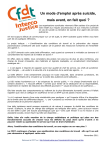

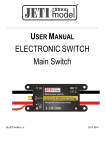

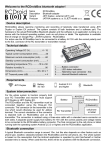


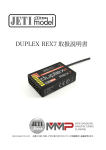

![LI N°93 [novembre 2014]](http://vs1.manualzilla.com/store/data/006492222_1-039b46bb9f997b9af2c8ab932832ddd9-150x150.png)
